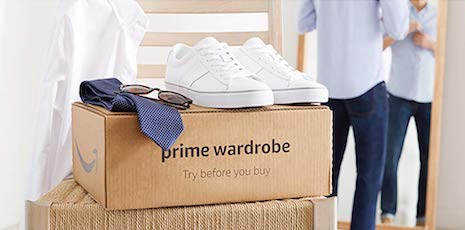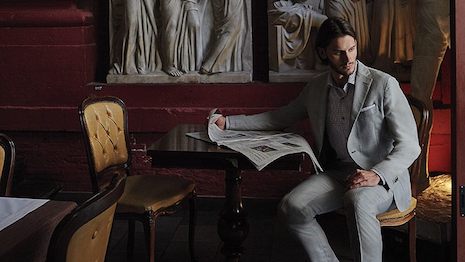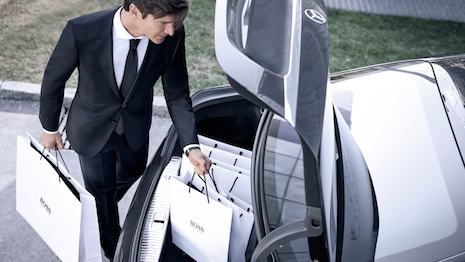Countering stereotypes about the buying behavior of men and women, new research finds that men today shop more frequently than women.
Per a study by First Insight, about one in five men shop six or more times at luxury department stores per month, compared to only 5 percent of women. As men shop more, luxury retailers need to find ways to reach out to these consumers in a crowded field.
"Based on our research, the male consumer is connected, informed and is shopping frequently," said Jim Shea, chief commercial officer of First Insight. "They have more choices than they did 10 years ago so there is more competition for their attention.
"Retailers should be focusing on product differentiation in order to convert these male shoppers," he said.
First Insight’s “The Arrival of the New Male Power Shopper” report is based on surveys of 1,000 consumers conducted in 2017 and 2018.
Frequent shoppers
Per the First Insight study, men are shopping more both online and in-store.
In 2017, almost half of men said they had never made a purchase via mobile device. This year, that figure has dropped to just 18 percent, putting them more on par with women when it comes to mobile commerce.
Additionally, men on average now make 41 percent of their purchases online, compared to 38 percent in 2017.
Sixty percent of men say their purchase frequency on Amazon has grown in the past year. Additionally, 53 percent say they shop at Amazon at least six times a month, whereas only 45 percent of women say the same.

Amazon's Prime Wardrobe. Image credit: Amazon
Men are also slightly more apt to use Amazon as their first point of reference for product searches, with 69 percent of men turning to the retailer compared to 63 percent of women.
Across all retail categories First Insight studied, men are more apt to shop frequently than women are.
Compared to other categories, luxury stores such as Saks Fifth Avenue, Neiman Marcus, Gucci and Prada have one of the greatest splits between male and female shopping frequency. While 19 percent of men shop with these stores at least six times a month, only 5 percent of women say the same.
New specialty stores also see men purchasing at a far greater frequency than women. Brands such as Allbirds, Outdoor Voices and Warby Parker see 20 percent of men shopping six or more times a month, whereas 5 percent of women report the same shopping patterns.
While there is less of a gap in purchase behavior for categories including mass department stores, traditional specialty stores and off-price retailers, men still out shop women.

More style options are leading men to shop more. Image credit: Saks Fifth Avenue
"It used to be that for men, there were fewer options and less newness, which meant men had less of a reason to shop," Mr. Shea said. "Also it used to be that the woman would shop for the man.
"All of this has changed in the last five to seven years," he said. "There is more variety, more excitement in men's categories and more of a reason to shop more often.
"There is also a trend toward more casual clothing, which is driving sales in men's products."
For retailers looking to reach men, one channel that is more prevalent among male shoppers is smart speakers. Compared to the 36 percent of women who currently own a smart speaker, 48 percent of men have the devices.
Among owners of smart speakers, men are also about 25 percentage points more apt to use them to research prices than women are.
Menswear investment
With a market size of $570 billion and annual revenues of $333.4 billion, the menswear category is expected to grow at a constant rate of 2-3 percent a year, according to a report by Fashionbi.
As size and revenues for the market have increased, so has consumer spending, with menswear seeing an 18 percent jump in purchases over the last five years. While far from a new market segment, menswear has seen a type of resurgence as men of all demographics have begun to embrace style and trends (see story).
Retailers are heeding menswear's rise, with efforts catering to male consumers.
For instance, department store chain Nordstrom embraced the growth of the menswear market with a launch of its first ever men’s only flagship.
On April 12, the retailer opened its doors to the new menswear store in New York. The location marks the first ever standalone men’s store in Nordstrom’s arsenal, at a time where menswear is flourishing (see story).
British department store chain Selfridges is looking to attract both male and female shoppers with a menswear space devoted to high-end streetwear, leaning in to luxury fashion's increasingly gender neutral, casual aesthetic.
Dubbed the "Designer Street Room," the retail concept has found a home in the menswear department and was developed with brand mixing and cross-category shopping in mind, including luxury labels such as Gucci and Versace. Selfridges' opening reflects consumers' high-low shopping patterns, as they curate wardrobes that blend a bevy of brands (see story).
"[Luxury retailers can reach male consumers] by creating experiences men value," Mr. Shea said. "Luxury is aspirational. It’s less about the logo or the badge and more about the experience."
{"ct":"Q7XniJh4m79mxBZHekA39D\/1BqdF7qvAHqAqpMOvCVR7QeuSUfA3+tpx1HM1SsT5xRLVllZoPmlzEBWlIzO6KOqGLnm6oTQ887wTaE+f1Nh3pr1JNFB4VvV4YyG\/BYL1\/Fuzneh7yR+e86D+d6v3pTYaVII+B6I4HWZR0s8ApE2DaVADqezSwTEs8yMKDgO1lIvgArtSEsqSa5ofgW6lNXcxS\/tRVLFPc\/G54F3ogoStoltIvwtmJUmAObPbb3UZWVuWdZS5QtmrkWMOLpwECmJdiofj4QB4PLQWcvjAO+zz04vX3CCSS2MOWTxQGYBD5vLJInhFJ7pSObn3kkknCqY9eWE7iq+ccrZ97x7E4g1MfH4LnSAAlN4rP2CSfw1ldHU1SnJBxpxOuqc\/YWi6IFgqs3pUi6tYN+witaCvYLsmBejBCN9z63RWC84KuSjSz1IY\/D\/cQXTKR5fSbZjekIa6J27UXPKARkAQJ33pRs2LudIbH2rmRkBaEjEe0Kp6LQutq6ocvyFVx+jPRdSZf57XSZJElpEBao3\/BZRb5\/66NNexbVYmetTi1ogJQRCiRtPV1de+VlN50Su3CX2CyL3rnWb1l+ze+szcaz\/\/XvFNq6hU\/9rN+wW9Hk+h3oErsn03UH\/Vxf2+l0M8VM+C\/tzZAAvl3JLhlK1CqVQtgQ3Yt0Eu+5Ky9hrS9TpWdfH2aykIEYyJ86Kdt45jY\/TIMiL8aJ75xL3VKs7PexkCaHlr3f9FMiUo8JwNItQzkHtKyhb9egnK8MvgUUhX4PMJ+pFkKD0ypiG2Yc7nw4rG5JfqcnKuHjWKHtQ6j3NRRyEGvEbXwP5TKPCXj9UlU0Z0fUSJX8XuUhQq20rGmcKBUax+xYpNHCVluM0bZfxRTdDzOZQWH9PrBwhnT70ExcGeWOf8QfYVSqJp0tARfuMADvrI\/OqZCg5AdPxxofSwNyy90ir3NSuXjcn0xkS1sl86MnUKuAVuMEKlTZdRN9UOKD2oYuztH4rop0AvsSJ2hEruzLEHG7elz1Jc7Kadi5YOdLiRvrVhoXnIGk1aeHcEnu607tYVRSS3RROhgJ934OqNB+d5h2dqtv\/N\/jAPQyhpMwNDZmIiavMO8g5RMjKbEFBxBsuc61127y2JNPpm\/Y7p+yCh7ig+VWNIMftWbTuys6DpPKZH2UrA8NApEOXsZJ3qaJ+iPwEPdnaQLdj7Q9m6gpZOS8ci1wDgK1lWy1sPy3FSmz\/wVlBdnqolsYti8ssZ1PbYGoztOcNhbhHQGJILST6+5srhoTRQx8uR3gzmp2Prjx0aJfq7cHo179VC\/Lc9dQAnUOPImUFGbOoqUjokW7OKbKfFD\/u0fnZehhFsMCu7YI+4RvG\/eKxb71hP5MQllVgS65kllQ+\/q0M\/oOIXZ2eF9vhEEBiX5DHcow+iJu7S9F80jrcWopIQfa7WgPjJYK4gimlCCFEZ3NI8BsqbH2GXHxJZfM8Fd\/d0AR8UT024eIvgin6ZDGlxJCr1D7HqsWK86c8OjIjM1RoTVrQbj7+FWf5VCMYgyTy2PvYw75x4V3mUfIZeH1s3PwGRvK5PqEJOAvQucvEy6As64O6EWhweOVrSClAbjK4zB3IEyJN66lbIA7MGAbuWU9jj65M5lYw9m5afdc3T0IKnIJSu3vP4KLXwBRymKDZ\/9Tis7RRJbBxP+69UsDUsE466Ji9uWtMqawNPY26kB2jgxQhtw7b8LpA\/EkBx+4frEHT6xomqP3AKNJEoDIE3FCMSqqIrqNWT0jBFKzvd1vJzryIHbQz7xrDJD+habQ3HZBaqhn7aHJt12mT+hyHOBqgNnEIzgWuYIPW3XK8FSrtR6gQGtJUI5vUTrtEc7+PMGpiXntnKW3kp49RKh2yxXmDvmkwNUy37j9Ehdon0ey6MposcIzij8MdrTP+T7swVrvPhQyT5mstmg1fo9YZmOhzgYm2rJLdQ\/eDEhwjOfaaW3wswpPhXFuvBQQ8FsF8ixlxnCzYrNbgd\/ySKd4WPCIIWZ98VoWR3UHbMM2J\/z+V8wwfIRZ83blMa85XXyDi3t8Ub0MSSl5z7sVWgZXZEm6zBpVPlmFXQ0qlbIgU0LlsvwTVIzzPCCBXOk2I9HWOm4hnj4ohglrdmts65Z6Rw5jLr0LkqMol3FxccEy6NrtOM6Gp4mjafV3EO8Upl2DKbMp3xjbCXgp7QdZ3kr8Wu3iBpDgDoI10qyfdkHm8ep8M5765UjKoivGI4s4LJuPtyClCfpYwG8nXqtFgS5rbaeKHiq9LFIUl5Gpwp2WIvkb3ARfSLwOO9UaavEe59WnCLCRQDseczFe\/hU3Qr3vxN2sB\/NkOhTEh0QuVFZM3mtsUTkJmAJQ+K3r833aWfpwtNj4JN7\/AKaVRWHQPpoY95sofA6cqN7YhwoKbhPVuUP4IgMvgMnxvoWLZ\/+NWqiKOaHbwiOSr876W3doMCS4NpgoJnJP\/wVH\/DfHeGLIjmUfzuORoB1Tj1sPBM27uuaHl3tozPchzbpPm5ry\/q9cR+oqZzn1FbicnaxRYyAl3ofCf9nMbcyfue18mzXlFLTSZWYmojeRhA+6\/EsbDWxBKVlUeK9Nylty9iPKskvIn2fNKd5FLcITyu2vLGIDA\/OHVIQRbrUSqzfRKXO1DORfNgzl5Q+KUsazh2cg9CoqlpB7qdLGNzhojZaDVROUaHVWXO8Y05BDWvxH5n\/zejhT4gszQu3Mq9QWOTCEX9IBQH7eEAJt7OBN5HOBEIGUbcgvZcd4q+LMb+rxkpJIc50o\/5CNWtKsp9gtUVkkFxmonqe+VsSVbuqg0hXnRxni1QDvW1kGjqII+ERGp8FNjd6SKdasBYJNdERmKEU2HiH2hYs9TCDuZEmic2grEepJd1fvMI6JBDXV+ZQghiyDVQ0JD7GXyh3gZA5Dlb+IGplKpybsTR6tb1o5IRgeN1R93w7Ny46EbWKOiiO8HyAaer4dP0\/TpIVl45bQibOOpWW9SZlB6HCcp8OagIadiQZndJUscEjvCA0wxIDKI\/n328KG0GiPkHlaoLJ5WQAS7PWhy+pNLanHI3+P\/O4QHoQ8oq7GdWJKLO48ApU69p298VwuUJH+hWzUAf1RM0wS5bL8wdDz0E4odbgRH8fIdUd8kdwahh9r17yvcEg1lM2o7GDLkopETvwbdRUM0lJBEGZ5+WKobOtygiQjVKB4i9G8qZ7rRzbWh444BgqMfQrSj\/oQ92DGuBDZLj7Ug2ocb12\/RAKBHEkytKi4BYnp+jJmWO1cqP9dEoVCH7iE5SyXdWFspI9SPiFmFdK1mCyvYVW4Hd7YsrptLZylE\/9VQtVrIrr55KuUqaa3fQ1UK8SpfyCHNds3e\/CrOSvpk3O5qz0JmZ74jli3GVOCUbBwjUms+Q5PUG91iaPf9wi04eZSC8RZ\/cr7JgTDQ\/Td7Q5SP6sbOAmLirdyYfWwhRpY4jvsh4tFWg9d0dKA9ZLKiOBak57fmkVo5jg2CGdwGIuyf+WOlbbmF1\/b+fq9TPRW0gEbVywfk4EuusUY\/WRn5Ukgf9EG9jYYjuuQIgEGligNHXi\/NlWwM5zh\/K+f0WLKGElgVnTHfTCCyr16uC7+VD6oTWNZdSEdgurFjxdiaFQYMaNafemH9rx4zJHceb4hLaDIZzkaZnJbyJj5HwBWY+ij6Yf77YaRDRMIDbMLeztmeOX9nWeZe++yY1ndV1nrK7y27QtK443pRg5LnKNVJ7VfrwVcrMuJiHqO3mrcL\/6pdMLYv+D4kNdlSexxOj3JU5mc4Eks3GCBZidOeddddFMRJ\/Tc9HGReq62ckknkANJn9Hvyl7BcPwgZGrFih163JxWu1D5M7UWa6Dkpngk2sCcpOZwNPOkg8z1w724dNrJWRSZdGkHy3LXYQWxZT0DeY\/L3vcdcOL6BPwkUKKTnA4ZPPzhGFkN7yXQ6d+vbrdKm2UX0r7T\/8K+JJtr6nQRQL6KRTq\/oFtuCG2214q0gvaxPgOfDgDDrqqMggGLAPqHA4Um0EsS6aRi6eYVRMEK6++40J0E1og6PUxYzeBoGiKzkPdyL5Du3ze53R1tvplgb5MXrM5CDAYYuOWBK+DtbbfZmgM2UmD+9\/y2AkLErk+sWa2lYrQIbGyRpELUwe+1sWKa4HAoK4t\/mVoEL1VX+4vcOfZ2yWIaWGEjxEahpa8IVxTEXqh4dnzdX5l\/Gd+6DycE\/2tEkroXzund3R5WuIfCzR7+PP\/NCm7tnscKAtIEjoku0tCq7AFx4\/US9FXQxNJCIs0OX3vr\/NqoNOLDEqBaoM\/8D7FEIwyqIs8chVI2vC1734oWlxgm6xeLA1JYcsYR7E6zw6d0izWiqBY7xTEsmeM2ASklpX1B08Sbhepxsfmw3XAz3c68VsuAioQjsD+Z2mj4eFiMN8nLZ\/sxebHQ\/YUArj\/ylMScmKlIq1V1A4cJKL8wFejxbmFk3nWeV8mds2P4Wa515bBtW6DUCUsUXPg7rJH8MROfOOZYpnrhMJrV22g6Os4qxA1mgB21cE\/E+STUp2wiwP4gwFli+DYZTlZFRAQpLGyW7oPwaclgBvnTRpYPShS5JbniWjlkbBDnazQV2ziwpl2KwY\/iRRj1eG8PhSUCupsQ+nkDKD4k6moezsPTHBtj3+9EPg1LPPcY32wZQH+FABvXtuJ9tDh+VjIokr2MJkTo2uMDFfisAnX4ATVNmg\/mivr9yhJC64muM41aQRjdj2NxzPnZCXTBMDual0UbDw3JlSxJKwrqKZ3aI4xqAlcG1J2fzAanECF4hbwSpFFe13FTNNEy80730JJuMkU\/sLZc8glboKRogYrEUPhBuBnm7pSBKqC8MFfMNprxHHYkkMyuxHmRGdWIe6F9l8Jj6yH3w\/eFdd5IviN47dMLIq89brSwBC16\/VfYe3maEIAf3EDYw1Vh2AhA4W5kcLCv8SqKqEOJKqcnRPN3lFy6FB5kMvEUexocaFu0mIMJeHXS5YIObnLCiq5IsVcmrkaA+3X9ovDQMF1Kx\/dqZ3XJi\/dCujQrRG8BNptU1ewmZtLnJOUPQ90N2SgQnMfTG0Okmf6tXWuBI1Pg169EjP++hM8sGBPMAx4\/B8tZ\/BAmzkD+8qR1UAOn72f5QcQkSJMor5X1Kf+ukjxHlBfrVzafVO1BXrefiVo+GvVugEv4qSOkVGQVRHl\/IHueJuYbPUhWzj7cKu60Zf0apZIbwTx5R0A6Lj6nmpr6l8LzArp\/qt04rWcFmmYAdBIQsxMu7IfKYUBdgfYpd2Vc8pBxLIXQue\/F2331EdxYoROx5qpeXrBl2kT8i5ZQFWFHK2oWIFyE2usIIWDJZRCWarN3onyLWmb8KUOJOBtlwOVH1ciYFo2NOMnmWHLOKztVZwHu3dmg5JVyO8KV1dZEeHhFgI5NUdwe8IYgI4pIkEyGpdNMsdtATPcKzDNw7MHBaREbvJFahKRhmYAqAtuM5gsVU4sHuYLl\/c3eUjAEC92VJkzugmTrMQCcwz9\/s7LhhKwJK4jralN46RlZGXzGv3b8xUL9TRSf+un6OSWYBgP4Hcosozw80XOWcEhvgqzj5wGbORlXsv4P34T2Df9\/Y5HdQq\/uI34ddPjsmudpy0UKg8LOYgJ8MHb3nznpBpwEiInTffrqa0G7lAzlApRMT9zZTZKyxtGkTGrblbeyxpX0Cugc5l7lQ6lqwiQbmMzLXs0AbEMgsrjKje01buJHL1dGBdsiRJejK1dgbLPfusA+on8UJQTKs7y2r2S2kD3oQBmQKu5HguDvczLUWxO1kTfn3tfuz0lg+65aIGhG8PMkGBuYnapyBnWC9CuNHMxCMQQAuuAbMGiQwzn\/hEQ8\/p8U2IfV+3XikZIbNmCfVhfyKWYEefetqo0UqoLE5ZbXnW2J3puxW5Sq9RrxMvLkldlufdhRtfmOM9H32yr6Gh7BYmL02szKd6mxfbI3ypxYS+k1EmtzZJu1Zzaefu9VZYrEt8\/b4VoZwEoO+FYUx147wjpYsNmdPSvSUhxuMDdM4hLjhTu0gOuiy85k9tejt3YVQgOuOgTBgvshD1ByLPUKjDDjK\/LJ+cZFivmMjX0u4DtwuU7UQnIcZBmn8z3buvYehgw++HsTn7gQyAoECdL+k\/7Xe0GbtXZATCkEWF5EW0Hv4cZMxuEQJ+k7vvqpTq9cB7IHiVPY5bOSF3ZL87VT3vKQf5bEOS2hia7RQMx7nIu88KkBDsKKnB5+VmdQa9aDLtUY1mFPBjxlHXOjb0mN7HEpBsahJcrd\/DzgScCWb\/6QUJHBcphBlH52C1RTkcVjsCMhFpZM8I9MQiww3Ez3QpiMU\/4gX2+WD93wTVZXFQbQYlymG4TLn3Lf+DujR\/VeIBkhJBQJP+RPOrTU\/YOQSzihZFGEb1qLMBGX35AO408GiNw9WxezaKOAk794s+yjkse1M0XwDn0YH+4t6ZuUgnkvWLftcJwQLJOf+HK69524O5N1\/OKTU3lrM3Gm7TODYN2cWSIvU9xOdWzhA2ajuWFcfgw38Oue3id1\/XZCS2OOrJ2UXjDlzVyBAU65FXUXayjAX7Pgq8p7nEGvbgMiJci9ezRFyEl39KaNI9+h3D3p4tCdg6nyIArfvQvP8FoLN9t7LzpUpGyyy28UZHbr4e+EFa58vLxXTir38qqPffIVA0yA8BEzJ7nN7E7t9uFNYG0oZfCA+zYZfYroBdimU0QjOqGC0K+9HC0ubXpX9fzmHzpjYo+lSXQ8BSSmenFRIEq54w2nFt0KactUApEyhWw2WEiKSGH7+lqT8eLvk5sZhAmTSn9E87EtdlFIvCJCE3FE+IEGs4hcic\/v8ArOM8EaY+nj0I78kn78rwJq\/Amhd\/K0C7WGlOnWtiSZ0AUL8Nz8Oof9jQmKFED\/GW5EhUInhSDh5CYyI4tQho7b2aqnB9P5oVeOiVEcqkfUWHgM4w1np7fEtqX1pMTD1E6aDNpKbg8bZJTiNe+iR9ZANE56i\/RlDl+F9hzBK03Ppx99iURkCg\/k\/BlKLkwCjhZeJlvZ\/2dJAl4cs0Dcy4y1DhvJ4EVosDzSrPy\/VITGzPgVzcHFzYUeIFP4SUPwHhgm1vZbJRE87mRoda4eMPw7ElncXKrEZD6ZFs0BOl5zYNyFx9poD9OFzMk\/kx9ms8Y5uk5RMfeukpfmG7gzIb4g3dOUBMkcipTTipEA1ZgCs+sfJ8MfEu47etAq8hNb97HLFl1x78BFnBzlN6JEfLmNHMZZk92z\/PTjZkYR7jFL11g1h\/9ShlKPkQEHFMnMWwIMts3mWtDFQ+cK22cRBfs+4T3NBvtz45GBwZF+qt4ln1D6jcaL+M\/lENSfMuRW9tX4JoHgI2qVdR1MwXXuWu26i7C0tG+hx\/+E2nfThECe6SgOljDEHmXMChAzqPXe1+IDb14G1RZfxqcYbbPLpV7pRH0cOawWBZQIinc0CMnqKk6BPtx9scDtei9Mu2wH5tTRkT4FERkGRrK0exuw04vKaR9RqrI0yj5XfS6iZmn2Sl427KeuKhZPA+zGXPRPyvMjdKIP0iFUjhUBqeRnH4yYTQUWXXqNI8JBl7UcgzFr9fTMMkqWrGG9ybHFlDb36RVeXyDIxzcsnupXiWVul1E5ao8EMROshf8NqCRaDnIXqquFRCPMNuypbF+jAJiOLQGKKASjBZuR0HRleMx0P+QHWdyouaZZ38n6xNMdL0eFH9WeG7A9\/5bk\/R288yFW1LkPj28YY5Yg\/2SNqfydjCndkl6Etc2+mVv0eUiLoY\/9CjYbO14S+3S4CRzOmEB4eUlGumY1vzqZOXHQ81aNekAIvSWZA+\/70baSb9G8+ux\/pcCPALgZ+eFAWcD\/C9IASFIMIwnhWC+gWFHUxV2Upl3dVTVxTYKNQVF8NDx3ut2L\/43ugOwv8oQvn66d9nJKhR\/ukLWvAkUf6n8zJY1kF9Nr0Y1RxYpREPF64p8mUsxavh4omRL531lLQgnmfZjFSIgKMsKyVheL6sImK9Z3icM\/a5alUoQJE6t0vvVA6i2splZgplrno9\/MRYEJJtzain8XRv8MeseCnJK7C3oYkr0CMJ+w+dbvJgKmKUloePCd\/qEq3E3L5RJmG7zDEp+W+qKtuuYbgURuk3GlPRKV+Uuzouvulrmon+JuYEpxYzbs4XC03Fytb0Wg39vtCfVmmyCQkuya\/YumgGx5aVtUHK9QF2ioNzsAT6j9psWVsZONHNGOjc5dF4xnUv\/bNp7vQ3VCCSYtWg35qs1RGl7oyb8MOvdLrE+R20PAc5jlESDEPH0MacQkP4XWqZFinCgOnK4gMvJJnWu9gilmrJV6vDHlFgMdK3S9Co6ndoZnZ8ZU0bbC0RwzwpZES1F0p2FnT69WAuTM0UCNbcg30GpoVM\/xElvpnN+MvP+GmJGBEEp1U\/xCNrak\/f9VfR2AgTNXChIBqiwuoSSvVkRi+ajeqz7MeXpa6ydqd8+B6Oew8YxadXV5NQjvVp\/oFWaIGngVkdcQlErpnGD45wBsdikv1pJLgQXLYflTIPCPe0Gv9T1PADxRZ3UfePODgGXj4JJkMRouURyR7Z2+x+QkTBITy7JSapcAfUBnDDfCQR\/avxNX\/woO1MMv2Oa3FLO28LmYDrdx\/172lMg8BT1uhZIhQSJKQ5l7qtEteNCZ7UuTO9VQXY+zfZPKYV8JqeRfy8NTcuUq0yUcScEgyfiM4KETcpe2f9FH8CDPWYmBDBA7\/qcL+QcnOnMA4vsH5hoT1oe6oAPZpMbUtF9RGCGC1RVx9TFt+GdWX6FnGAx8JHg01Pf+\/GsofZtUvoIboZ5gnqTRO5wIYCqM4AYnbGybk10ZadC5wCZWZS9ME5gXy7LFduI04sDaHMInPgTVjtKrK6TGJT\/lkUn38AJev\/O30RuRz26o6ujz3WaRAw6wh9qW\/NfZrmi3B1nEuk109XV9I1DfGbhc320xWeFSRSXPRvIsxsv25++ERgMD94FHpN3CYDpS8xVJAEVqG\/EcI3rqvbO4NHJS660D6raHrt0YxOT62Kb8Kas9u76u4pp+yZRFpDDDcDdrhRsL0UDA4=","iv":"81fa7bf988fa77610ae8869721e938ee","s":"87d419bf1c0c4349"}

 Male shoppers tend to buy more frequently than women. Image credit: Hugo Boss
Male shoppers tend to buy more frequently than women. Image credit: Hugo Boss